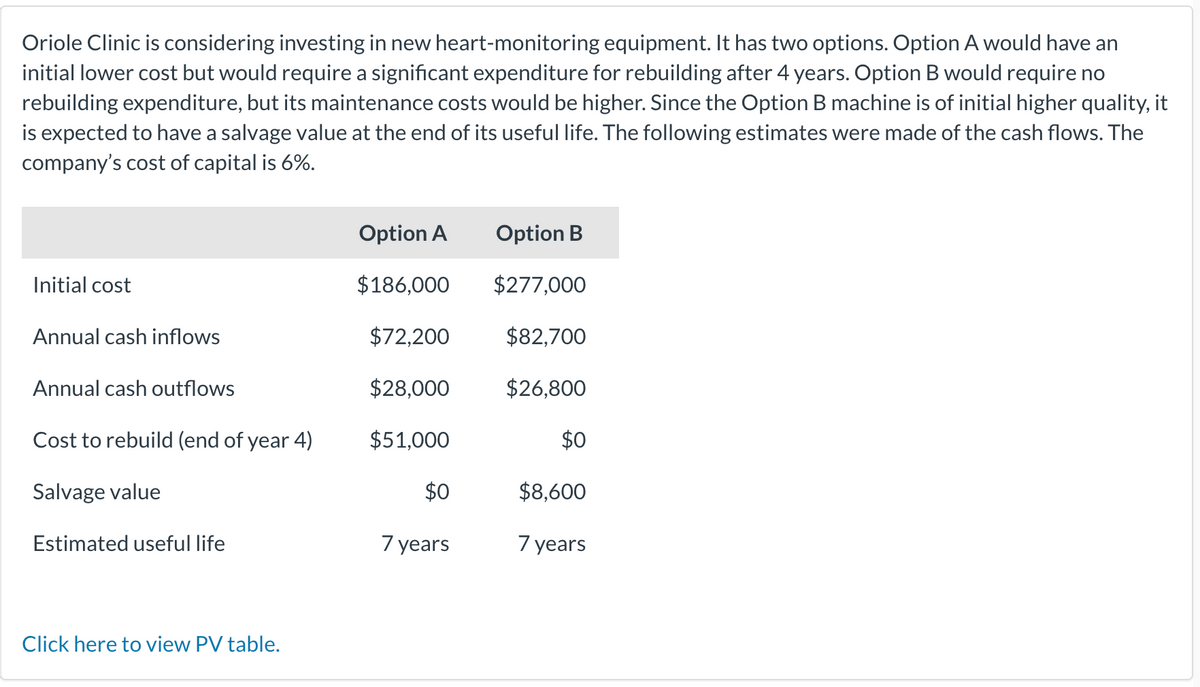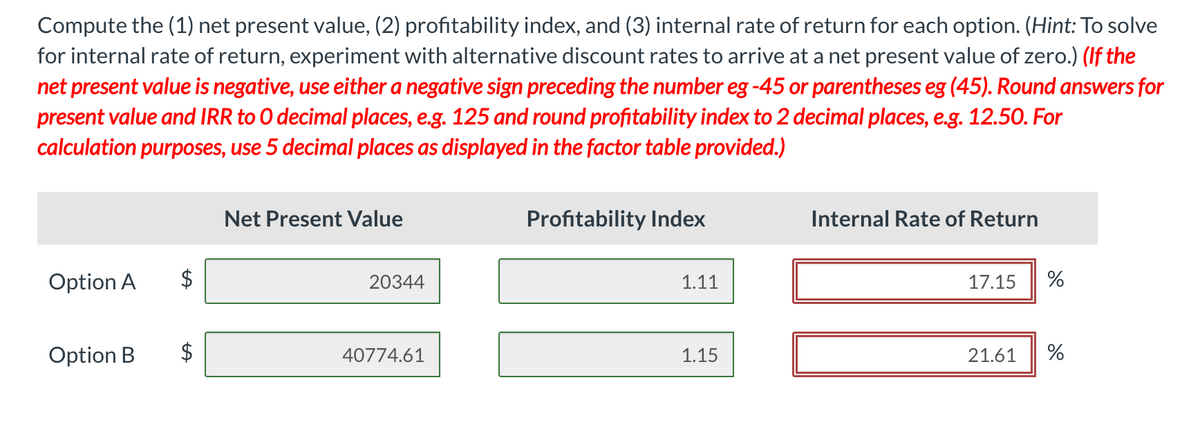Oriole Clinic is considering investing in new heart-monitoring equipment. It has two options. Option A would have an initial lower cost but would require a significant expenditure for rebuilding after 4 years. Option B would require no rebuilding expenditure, but its maintenance costs would be higher. Since the Option B machine is of initial higher quality, it is expected to have a salvage value at the end of its useful life. The following estimates were made of the cash flows. The company's cost of capital is 6%. Initial cost Annual cash inflows Annual cash outflows Cost to rebuild (end of year 4) Salvage value Estimated useful life Option A $186,000 $72,200 $28,000 $51,000 $0 7 years Option B $277,000 $82,700 $26,800 $0 $8,600 7 years
Oriole Clinic is considering investing in new heart-monitoring equipment. It has two options. Option A would have an initial lower cost but would require a significant expenditure for rebuilding after 4 years. Option B would require no rebuilding expenditure, but its maintenance costs would be higher. Since the Option B machine is of initial higher quality, it is expected to have a salvage value at the end of its useful life. The following estimates were made of the cash flows. The company's cost of capital is 6%. Initial cost Annual cash inflows Annual cash outflows Cost to rebuild (end of year 4) Salvage value Estimated useful life Option A $186,000 $72,200 $28,000 $51,000 $0 7 years Option B $277,000 $82,700 $26,800 $0 $8,600 7 years
Financial Management: Theory & Practice
16th Edition
ISBN:9781337909730
Author:Brigham
Publisher:Brigham
Chapter10: The Basics Of Capital Budgeting: Evaluating Cash Flows
Section: Chapter Questions
Problem 12MC: You are also considering another project that has a physical life of 3 years—that is, the machinery...
Related questions
Question
ss.
Subject :- Accounting

Transcribed Image Text:Oriole Clinic is considering investing in new heart-monitoring equipment. It has two options. Option A would have an
initial lower cost but would require a significant expenditure for rebuilding after 4 years. Option B would require no
rebuilding expenditure, but its maintenance costs would be higher. Since the Option B machine is of initial higher quality, it
is expected to have a salvage value at the end of its useful life. The following estimates were made of the cash flows. The
company's cost of capital is 6%.
Initial cost
Annual cash inflows
Annual cash outflows
Cost to rebuild (end of year 4)
Salvage value
Estimated useful life
Click here to view PV table.
Option A
$186,000
$72,200
$28,000
$51,000
$0
7 years
Option B
$277,000
$82,700
$26,800
$0
$8,600
7 years

Transcribed Image Text:Compute the (1) net present value, (2) profitability index, and (3) internal rate of return for each option. (Hint: To solve
for internal rate of return, experiment with alternative discount rates to arrive at a net present value of zero.) (If the
net present value is negative, use either a negative sign preceding the number eg -45 or parentheses eg (45). Round answers for
present value and IRR to O decimal places, e.g. 125 and round profitability index to 2 decimal places, e.g. 12.50. For
calculation purposes, use 5 decimal places as displayed in the factor table provided.)
Option A
Option B
$
$
Net Present Value
20344
40774.61
Profitability Index
1.11
1.15
Internal Rate of Return
17.15 %
21.61 %
Expert Solution
This question has been solved!
Explore an expertly crafted, step-by-step solution for a thorough understanding of key concepts.
This is a popular solution!
Trending now
This is a popular solution!
Step by step
Solved in 3 steps with 4 images

Knowledge Booster
Learn more about
Need a deep-dive on the concept behind this application? Look no further. Learn more about this topic, finance and related others by exploring similar questions and additional content below.Recommended textbooks for you


Intermediate Financial Management (MindTap Course…
Finance
ISBN:
9781337395083
Author:
Eugene F. Brigham, Phillip R. Daves
Publisher:
Cengage Learning

Cornerstones of Cost Management (Cornerstones Ser…
Accounting
ISBN:
9781305970663
Author:
Don R. Hansen, Maryanne M. Mowen
Publisher:
Cengage Learning


Intermediate Financial Management (MindTap Course…
Finance
ISBN:
9781337395083
Author:
Eugene F. Brigham, Phillip R. Daves
Publisher:
Cengage Learning

Cornerstones of Cost Management (Cornerstones Ser…
Accounting
ISBN:
9781305970663
Author:
Don R. Hansen, Maryanne M. Mowen
Publisher:
Cengage Learning

Excel Applications for Accounting Principles
Accounting
ISBN:
9781111581565
Author:
Gaylord N. Smith
Publisher:
Cengage Learning

Managerial Accounting: The Cornerstone of Busines…
Accounting
ISBN:
9781337115773
Author:
Maryanne M. Mowen, Don R. Hansen, Dan L. Heitger
Publisher:
Cengage Learning

EBK CONTEMPORARY FINANCIAL MANAGEMENT
Finance
ISBN:
9781337514835
Author:
MOYER
Publisher:
CENGAGE LEARNING - CONSIGNMENT